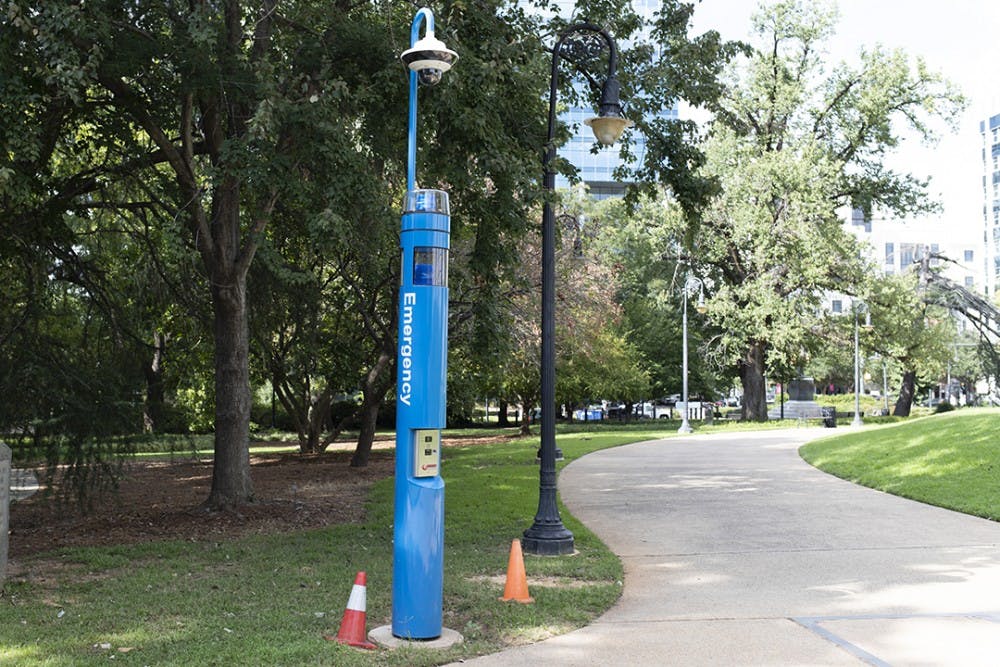The Firehouse Sub Public Safety Foundation donated $27,000 to the USC Division of Law Enforcement and Safety (DLES) to place trauma kits in multiple buildings at USC, a move the department says will increase safety on campus.
“As South Carolina alumni, it is extremely satisfying to be able to give back to our alma mater,” Firehouse franchisees Larry and Jody Chandler said in a press release.
Currently, about 29 campus buildings have a total of 41 trauma kits in case of emergency. The trauma kits include information for first responders so they can adequately assess and address the situation until USCPD arrives.
“If there’s some type of an incident, whether it be an injury or let’s say there’s other type of situation where someone is injured, then anyone can open up this kit and then there are very simple, straightforward instructions,” said DLES Capt. Eric Grabski.
Grabski hopes the trauma kits will allow someone to receive care during the inevitable response time. In addition to the trauma kits, USC PD emphasizes campus safety through presentations, self defense classes and a variety of safety resources.
“Safety isn’t always one of the subjects that’s just fun to bring up, but we know that safety is really the number one concern for ... most parents,” Grabski said. “How safe is their student? How safe is the campus?”
The RaveGuardian app is the primary campus safety app for USC students. The app recently underwent an update that offers more features.
“In the last couple of months it’s become a little bit more user-friendly,” Grabski said. “It takes less steps to get it onto your phone. It’s also got a resource page that’s on there so you can go to that part of the app and find multiple resources to help you stay safe.”
One of the most visible resources for campus safety are call boxes with red or blue lights. These boxes connect students directly to USCPD at the touch of a button and allow students to explain the problem to an officer.
However, some students like third-year early childhood education student Maggie Baker have concerns about whether some of these boxes are operational.
“I hope that there’s one around that works,” said Baker. “There’s one by the band field that wasn’t working the other day when I walked by.”
Grabski said that some call boxes may be new and have not been put on the network yet, which is why they have an "out of order" sign. He added that if a student believes a call box is out of order, they should call USC PD’s office so the issue can be resolved. Whether the light at the top is shining red or blue is not an indicator of a problem with the call box, but an indicator of when it was installed.
The newer boxes have a blue light at the top with cameras installed so officers can hear and see what the situation is, assess it and initiate the appropriate response.
For students like third-year political science student Matthew Long, that's a reassuring feature.
“I feel like if there was ever a problem it’d be very helpful,” he said.
Through safety presentations and defense workshops, Grabski hopes students will understand how to embrace their own safety. Over 30,000 students walk the USC campus every day. Grabski emphasized that when students take some of the responsibility and equip themselves, USC can become a safer campus.
“One of the main things we talk about is really just also taking personal responsibility for safety so not falling into the thought that your safety is someone else’s responsibility,” Grabski said. “That’s really great for here on campus, but it’s also really great as our students move on and become a professional somewhere and live in a neighborhood and have families and that type of thing.”
Grabski hopes the safety resources will also inspire parents to have a candid conversation with their student about how to approach different situations and how they can stay safe in Columbia.
“Fortunately we have a very safe campus, but what we advocate is for parents to have really meaningful conversations about safety and what that means,” Grabski said.

